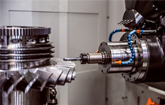PolyU Celebrates 2nd Anniversary of the Aviation Services Research Centre
HONG KONG, November 16, 2015 /PRNewswire/ --
The Aviation Services Research Centre (ASRC) co-founded by PolyU and Boeing enters its second anniversary this year and is a successful example of research and innovation collaboration between academia and industry. Over the years, it has conducted academic research in advanced aviation Maintenance, Repair and Overhaul (MRO) technologies, providing enhanced operating solutions to the labour intensive MRO industry. PolyU today (16 November) held a celebration ceremony and announced the research achievements of two projects supported by the Innovation and Technology Fund (ITF). These two research innovations enable automation of aviation maintenance procedures like replacement of aircraft outer skin panels and restoration of aviation parts like turbofan blades and turbine backing ring seals to their optimum shapes. This can substantially reduce the turnover time for aircraft maintenance and airplane turnaround time, attracting more aircrafts to undergo maintenance in Hong Kong and bringing economic benefits by consolidating its position as an aircraft maintenance hub.
The ceremony of the 2nd Anniversary of the ASRC was hosted by PolyU Council Chairman Ms Marjorie Yang and officiated by Dr Dong Yang Wu, Vice President, Boeing Research & Technology China, Boeing (China) Co., Ltd. and Ms Annie Choi, Commissioner for Innovation and Technology. "The Aviation Services Research Centre has made substantial progress in our mission to provide advanced aviation education and undertake application-inspired research, and a showcase of research and innovation collaboration between academia and industry, thereby providing the human resources and expertise needed to foster the growth of the industry." said Ms Yang.
Dr Wu said, "It is very exciting to see the research progress made by the ASRC in developing technologies, which serves as an excellent example of industry-academic collaboration to enhance the capacity, capability and efficiency of aircraft maintenance operations to support sustainable aviation growth in China."
Ms Choi said, "We believe the ASRC can help Hong Kong strengthen its position as an international aviation hub, and further develop as an aviation education and research centre in the region."
An aircraft outer skin panel could have more than 200 rivet holes and the panel undergoes shape change after flight. Currently, when aircraft parts require replacement, prefabricated new panel with rivet holes drilled cannot be used directly in aviation MRO. This is why aircraft parts are refurbished manually by aircraft maintenance professionals. The ASRC utilizes a laser tracker or other 3D measuring devices and a software system to accurately produce drilling templates for manual drilling on new replacement panels. In addition, researchers have also developed a laser tracking technique and a software system to measure the existing hole positions on the airframe and transmit drilling location information to a pair of robotic arms which drill those hole automatically. The use of semi-automated or fully-automated methods in laser assisted replacement of an aircraft outer skin panel can reduce the replacement time from five hours to less than half-an-hour.
In addition, aircraft parts such as the edge of turbo fan blades and turbine backing ring seals suffer from distortion after long-term usage, making individual parts unique. As such, prefabricated aircraft parts cannot be used and are refurbished manually by aircraft maintenance and engineering professionals. The ASRC used Starrag STC 800, a 5-axis machining center, to implement multi axis probing technology and determine the optimum machining parameters of the fan blade to ensure uniformity of form and accuracy of the refurbished components. In addition, researchers have also developed a mechanized method to remove distortion from turbine backing ring seals. This machine is highly accurate (accuracy within 0.5mm) and can be used for the refurbishment of turbine backing ring seals of various diameters. The use of automated precision machinery and software system to assess the optimum machining parameters of the fan blade and ring seals and to refurbish them can reduce the turnaround time for refurbishment from three days to one day and increase their accuracy by more than 90%.
Hong Kong has a leading position in Asia as a provider of MRO, with the world's largest MRO company headquartered in the city. However, the local MRO industry faces a shortage of manpower and high turnover in recent years. These two research projects have seen the development of semi-automated and fully-automated machining solutions for the aviation MRO industry, solving the manpower shortage problem of the industry, improving the quality of the repair, and shortening the time of repair. The professionalization of the industry will also help nurture industry professionals and attract more graduates to join the aircraft maintenance and engineering industry.
The ASRC will continue to embark on academic research in advanced aviation MRO technologies, promoting knowledge transfer and contributing to consolidating Hong Kong's leading position as a world-class service provider of MRO.
Press contact: Professor Alex Wai
Vice President (Research Development)
Telephone: +(852)-2766-6231
Press contact: Dr Stephen O'Brien
Director of Operations, Aviation Services Research Centre, PolyU
Telephone: +(852)-2766-7600
Hung Hom Kowloon Hong Kong
香港九龍紅磡
E [email protected] T +(852)-2766-5101 F +(852)-2364-0246
http://www.polyu.edu.hk/cpa
SOURCE The Hong Kong Polytechnic University
WANT YOUR COMPANY'S NEWS FEATURED ON PRNEWSWIRE.COM?
Newsrooms &
Influencers
Digital Media
Outlets
Journalists
Opted In




Share this article